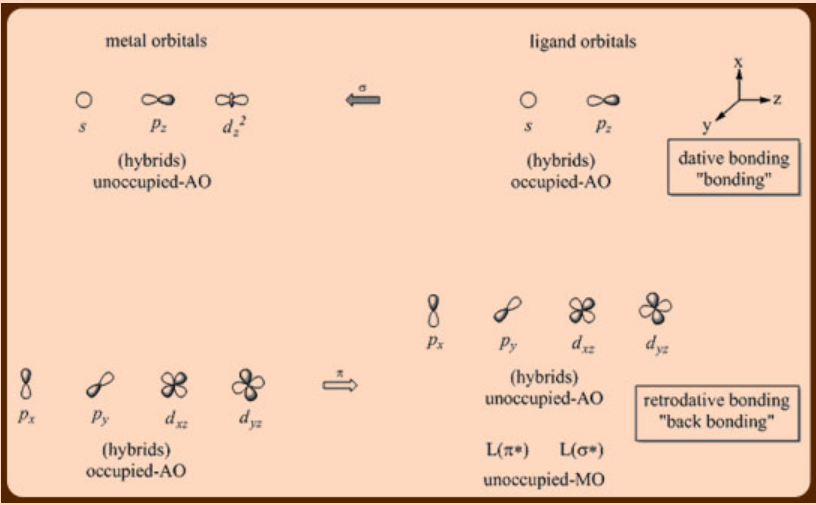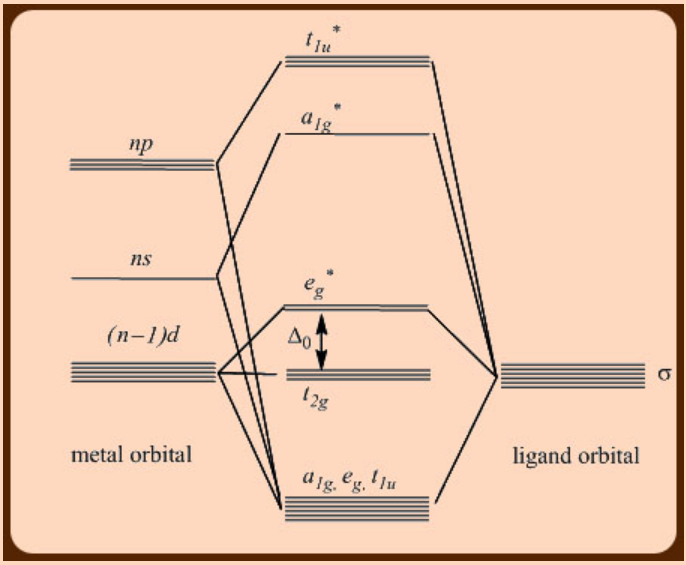6.1: 18 Valence Electron Rule
- Page ID
- 360901
Learning Objectives
In this section you will learn the following
- Have an insight about the stability of the transition metal complexes with respect to their total valence electron count.
- Be aware of the transition metal complexes that obey or do not obey the 18 Valence Electron Rule.
- Have an appreciation of the valence electron count in the transition metal organometallic complexes that arise out of the metal-ligand orbital interactions.
The transition metal organometallic compounds exhibit diverse structural variations that manifest in different chemical properties. Many of these transition metal organometallic compounds are primarily of interest from the prospectives of chemical catalysis. Unlike the main group organometallic compounds, which use mainly ns and np orbitals in chemical bonding, the transition metal compounds regularly use the (n−1)d, ns and np orbitals for chemical bonding (Figure \(\PageIndex{1}\)). Partial filling of these orbitals thus render these metal centers both electron donor and electron acceptor abilities, thus allowing them to participate in σ-donor/π-acceptor synergic interactions with donor-acceptor ligands like carbonyls, carbenes, arenes, isonitriles and etc,.

The 18 Valence Electron (18 VE) Rule or The Inert Gas Rule or The Effective Atomic Number (EAN) Rule: The 18-valence electron (VE) rule states that thermodynamically stable transition metal compounds contain 18 valence electrons comprising of the metal d electrons plus the electrons supplied by the metal bound ligands. The counting of the 18 valence electrons in transition metal complexes may be obtained by following either of the two methods of electron counting, (i). the ionic method and (ii). the neutral method. Please note that a metal-metal bond contributes one electron to the total electron count of the metal atom. A bridging ligand donates one electron towards bridging metal atom.
Example 1: Ferrocene Fe(C5H5)2

Example 2. Mn2(CO)10

Transition metal organometallic compounds mainly belong to any of the three categories.
- Class I complexes for which the number of valence electrons do not obey the 18 VE rule.
- Class II complexes for which the number of valence electrons do not exceed 18.
- Class III complexes for which the valence electrons exactly obey the 18 VE rule.
The guiding principle which governs the classification of transition metal organometallic compounds is based on the premise that the antibonding orbitals should not be occupied; the nonbonding orbitals may be occupied while the bonding orbitals should be occupied.


Class I:
In class I complexes, the Δo splitting is small and often applies to 3d metals and σ ligands at lower end of the spectrochemical series. In this case the t2g orbital is nonbonding in nature and may be occupied by 0−6 electrons (Figure \(\PageIndex{2}\)). The eg* orbital is weakly antibonding and may be occupied by 0−4 electrons. As a consequence, 12−22 valence electron count may be obtained for this class of compounds. Owing to small Δtetr splitting energy, the tetrahedral transition metal complexes also belongs to this class.
Class II:
In class II complexes, the Δo splitting is relatively large and is applicable to 4d and 5d transition metals having high oxidation state and for σ ligands in the intermediate and upper range of the spectrochemical series. In this case, the t2g orbital is essentially nonbonding in nature and can be filled by 0−6 electrons (Figure 3). The eg* orbital is strongly antibonding and is not occupied at all. Consequently, the valence shell electron count of these type of complexes would thus be 18 electrons or less.
Class III:
In class III complexes, the Δo splitting is the largest and is applicable to good σ donor and π acceptor ligands like CO, PF3, olefins and arenes located at the upper end of the spectrochemical series.
The t2gorbital becomes bonding owing to interactions with ligand orbitals and should be occupied by 6 electrons. The eg* orbital is strongly antibonding and therefore remains unoccupied.
Problems
State the oxidation state of the metal and the total valence electron count of the following species.
1. V(C2O4)33−
Ans: +3 and 14
2. Mn(acac)3
Ans: +3 and 16
3. W(CN)83−
Ans: +5 and 17
4. CpMn(CO)3
Ans: 0 and 18
5. Fe2(CO)9
Ans: 0 and 18
Self Assessment test
State the oxidation state of the metal and the total valence electron count of the following species.
1. TiF62-
Ans: +4 and 12
2. Ni(en)32+
Ans: +2 and 20
3. Cu(NH3)62+
Ans: +2 and 21
4. W(CN)84-
Ans: +4 and 18
5. CH3Co(CO)4
Ans: 0 and 18
Summary
The transition metal complexes may be classified into the following three types.
- The ones that do not obey the 18 valence electron rule are of class I type
- The ones that do not exceed the 18 valence electron rule are of class II and
- The ones that strictly follow the 18 valence electron rule.
Depending upon the interaction of the metal orbitals with the ligand orbitals and also upon the nature of the ligand position in spectrochemical series, the transition metal organometallic compounds can form into any of the three categories.

